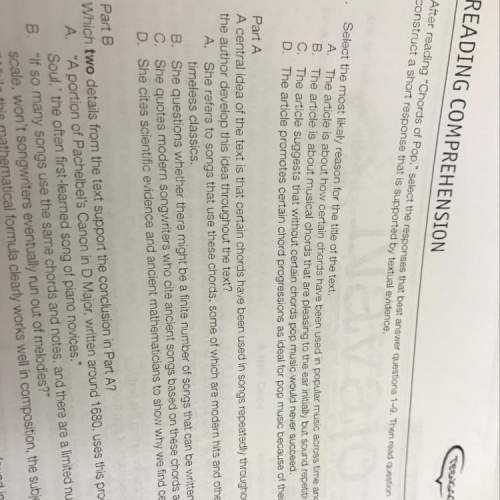
English, 20.04.2021 06:40 boxergirl9875
Can someone help me answer this question “How and when are developmental progressions used in the teaching cycle? " in the text below is the answer but I can’t find thanks.
In practice, formative assessment ranges from informal to formal, reactive to planned, and brief to extended (Orland & Anderson 2013). For example, a teacher might
make a quick note on the fly about a question a child asked. In documenting a moment of learning in this informal way, the teacher might not necessarily have
in mind how the question may be tied to indicators of progress; the teacher might also have briefly reflected on the meaning of the child’s question before responding.
Formative assessment is a key part of instruction aimed at understanding children’s current and next levels of learning.
A more formal assessment might look very different.
For example, a toddler teacher might have planned
to formatively assess children’s progress in learning about cause and effect. While looking for examples of children’s experimentation with cause and effect in their self-directed play, she might notice a toddler dropping objects to find out which ones bounce and then, over several days, trying new strategies (dropping them from different heights, throwing them) to see whether they bounce higher. To determine the child’s current and next levels of learning, the teacher might take a series of photos and link the photos to learning progressions for understanding cause and effect. As part of documenting the sequence of learning, the teacher might also note ways to support the child’s continuing exploration
of causal mechanisms, such as introducing new play materials in the environment, making sure the child has ample uninterrupted time to explore materials, and extending the play outside.
For intentional teachers, formative assessment is embedded in the curriculum planning process.
involves the ongoing collection of information through observation and documentation, including written notes, photos, videos, audio recordings, and portfolios
of children’s products. As documentation is gathered, teachers reflect on it. They continue reflecting as they organize the information, and as part of the process, they link documented moments of learning to research- based progressions of knowledge and skill development. Teachers’ reflection on children’s learning—individually and with colleagues, the children, and family members— leads to the planning of experiences, environments, and activities that further children’s learning.
To support intentional teaching, there are structured measurement tools, such as the Desired Results Developmental Profile (DRDP) (California Department of Education 2016), Teaching Strategies Gold (Teaching Strategies 2013), and Work Sampling (Meisels, Xue, & Shamblott 2008). These tools enable teachers to use the documentation they collect daily as evidence in rating children’s developmental progress and learning. As members of teams that created and guide the implementation of the Desired Results Developmental Profile, we devote the rest of this article to explaining the DRDP and how it supports teaching and learning.

Answers: 2


Another question on English


English, 22.06.2019 13:00
In chapter 34 of the awakening, how does the author reveal the contrast between arobin’s and robert’s characters? through the dialogue the two men have in the parlor by the different ways edna responds to them by describing them with contrasting language by placing them in opposite corners of the parlor
Answers: 2

English, 22.06.2019 13:50
Examine the imagery in these lines of the poem "the legend" by garrett hongo. he is asian, thai or vietnamese, and very skinny, dressed as one of the poor in rumpled suit pants and a plaid mackinaw, dingy and too large. he negotiates the slick of ice on the sidewalk by his car, opens the fairlane's back door, leans to place the laundry in, and turns, for an instant, toward the flurry of footsteps and cries of pedestrians as a boy—that's all he was— backs from the corner package store shooting a pistol, firing it, once, at the dumbfounded man who falls forward, grabbing at his chest. how does the imagery in these lines affect the reader’s experience of the poem? check all that apply. it creates a visual picture of the man. it conveys what the scene sounds like. it describes the actions of the boy. it reveals the poet’s opinion of the characters. it encourages readers to care for the characters. it shows the resolution of a conflict. it explains the reasons for the event.
Answers: 2

English, 22.06.2019 14:10
Select all that are essential to an effective introduction to a literary analysis. *a memorable clincher *the author and title of the work *a description of the setting *a thesis statement about the theme *a very brief summary of the text
Answers: 1
You know the right answer?
Can someone help me answer this question “How and when are developmental progressions used in the te...
Questions

Spanish, 12.04.2021 16:20

Biology, 12.04.2021 16:20





Social Studies, 12.04.2021 16:20

Mathematics, 12.04.2021 16:20

Mathematics, 12.04.2021 16:20


Business, 12.04.2021 16:20

Mathematics, 12.04.2021 16:20


Mathematics, 12.04.2021 16:20


Chemistry, 12.04.2021 16:20

Mathematics, 12.04.2021 16:20

Spanish, 12.04.2021 16:20





